"Congestion Prevention"

We showed how autonomous cars clear inevitable traffic jams in the previous page.
However, if we can prevent traffic jams beforehand, we can avoid using the system for recovering traffic congestion, so we can reduce more unexpected accidents.
In this page, we will show how effective the traffic jam prevention measures by autonomous driving for "when joining, slope and accident" which were mentioned in Cause of Traffic Jams and Solutions.
Purpose
People sometimes drive to cause a traffic jam unintentionally during running on slopes, curves and where merging or accidents happen. In order to prevent this, we will examine what types of system enable traffic jams to be resolved.
Details
- ①We make a model of Edobashi junction, which is particularly prone to traffic jams in the Metropolitan Expressway, and placed miniature cars all over the model.
We moved them slowly as time goes and took pictures of them at each time, to see what happens to the condition of the road crowding etc when changing the conditions when driving the car.
(When moving the car little by little, we considerd the confluence of cars, slopes, curves, etc.) - ②We focused only on the place where problems happen, and thought about how we could reduce or eliminate the traffic jams by using autonomous cars.
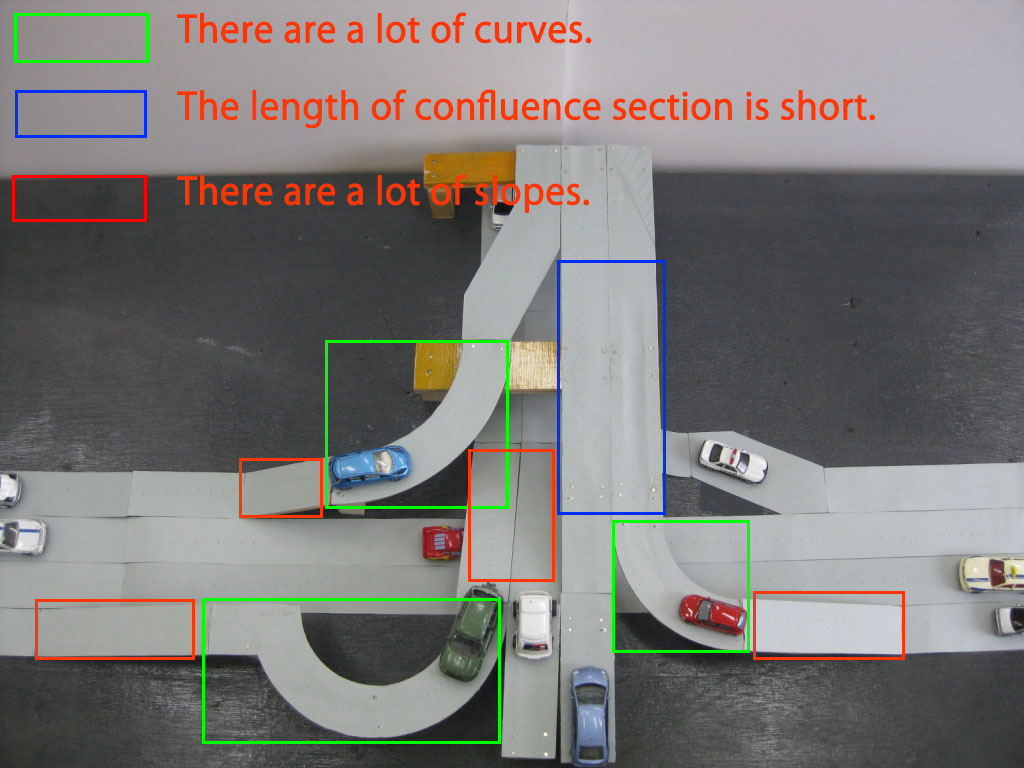
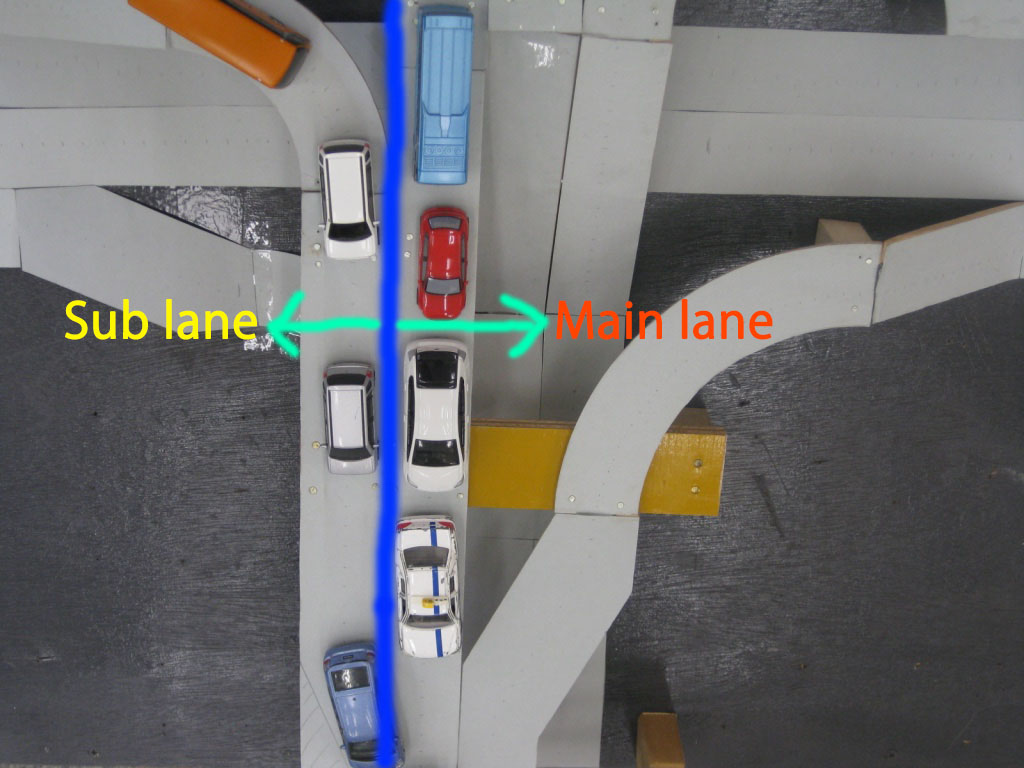
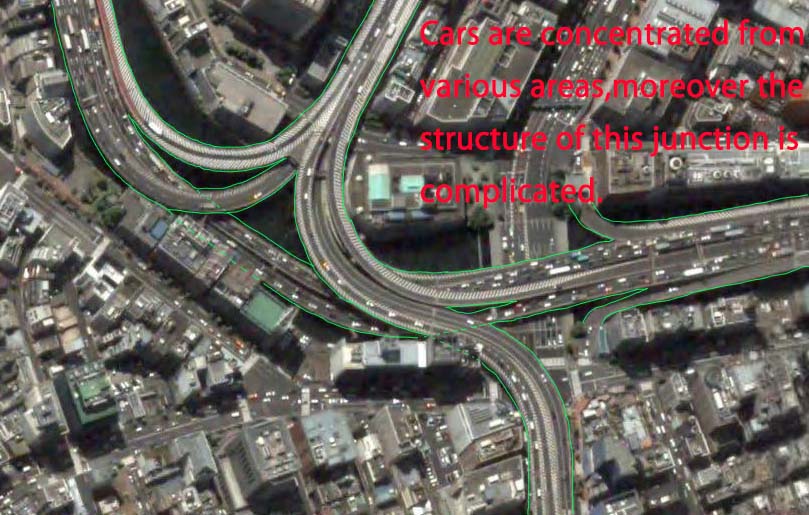 |
| Edobashi JCT Image © 2006 The GeoInformation Group |
Required Items
- Model of Edobashi JCT
- Minicars
- (camera)
Content
Experiment 1
To theorise how many cars we should allow to pass in the main lane, so we can change the way the cars running in the sub-lane enter the main lane.
(・In the curve or slope, the car runs at two thirds of the speed of a flat road.
・ An accident has not happened. ←You will understand what I mean later.
・The ratio of the number of cars in the main lane and the sub-lane is 2: 1.)
- ①The cars in the sub-lane are to join the main lane after one car in main lane passes.
(Hypothesis)The cars running in the main lane are likely to become crowded and the cars running the sub-line will move smoothly.

- ②The cars in the sub-lane are to join the main lane after four cars in main lane pass.
(Hypothesis)The cars running in the main lane are likely to move smoothly, and the cars running the sub-lane will become crowded.

- ③The cars in the sub-lane are to join the main lane after two cars in main lane pass.(We think this is the solution.)
(Hypothesis)Cars running in the main lane and the sub-lane will run smoothly.

Experiment 2
Change the speed on curves or slopes.(An accident has not happened.)
- ①As we approach the curve or slope, cars run at two thirds the speed of a flat road.
(Hypothesis)Cars on the curve or slope will slow down, and it may cause traffic congestion to occur.
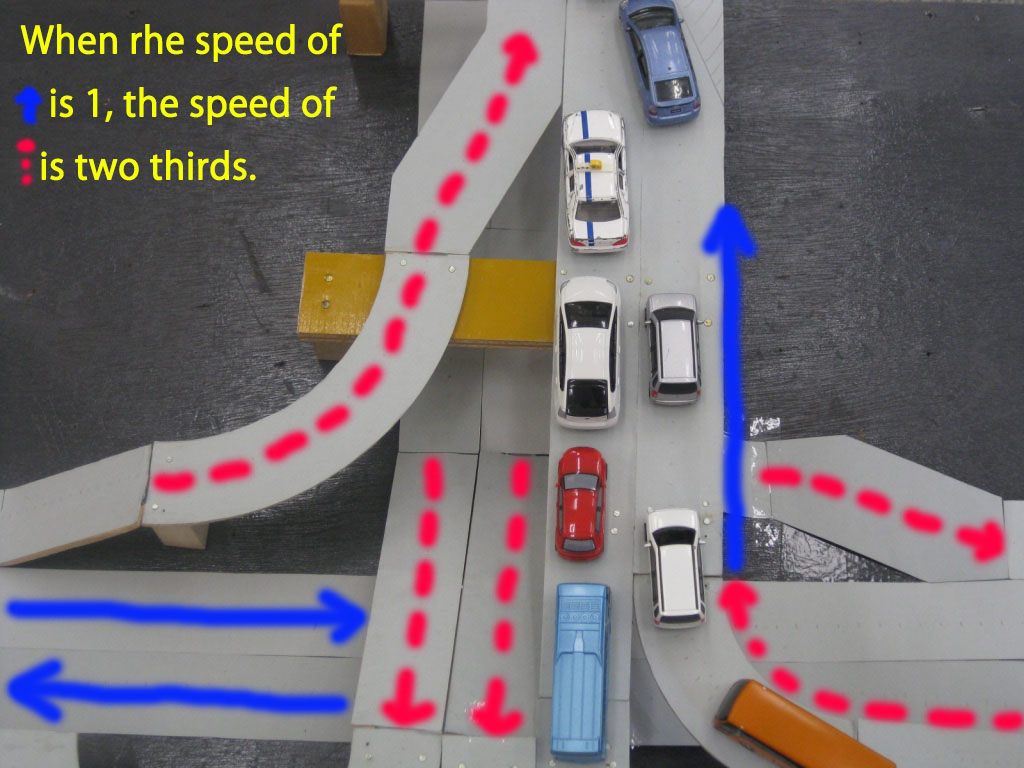
- ②The speed on the curves or slopes is the same as on the smooth road.(We think this is the solution.)
(Hypothesis)All cars run smoothly just like a flat part.
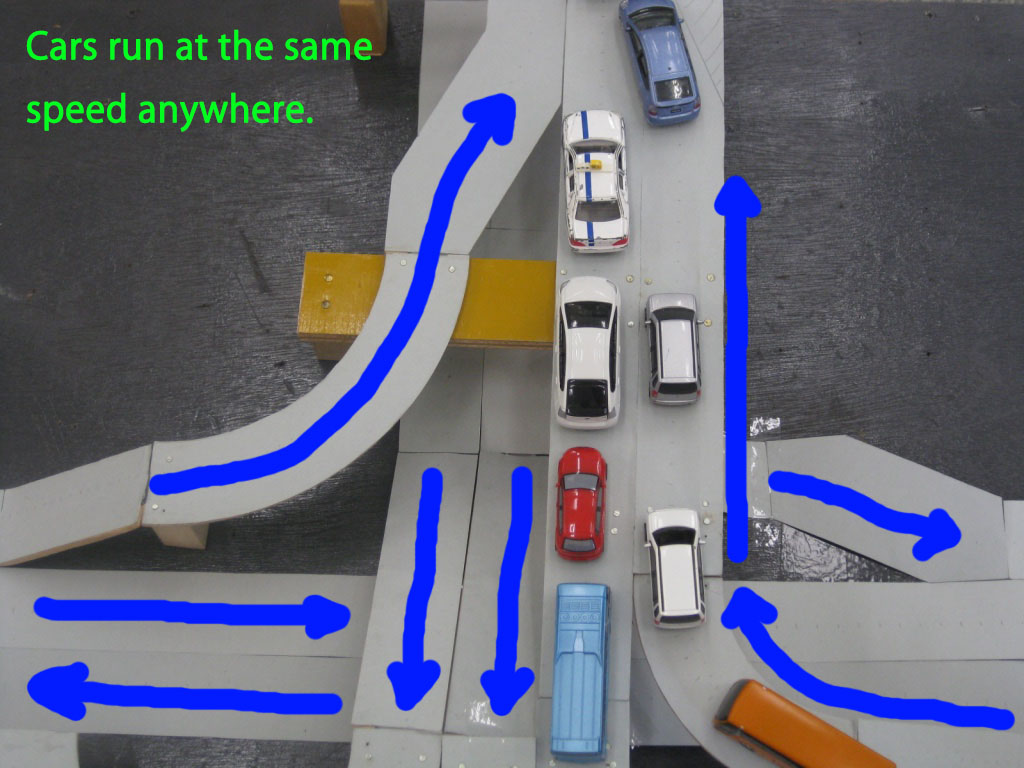
Experiment 3
Assuming that an accident occurred, change the place from where it happened.
(・As we approach the curve or slope, cars run at two thirds the speed of a flat road.
・The cars in the sub-lane are to join the main lane after two cars in main lane have passed.
・The ratio of the number of cars in main lane and sub-lane is 2: 1.)
I think that it is effective to apply the techniques used in the traffic jam recovery experiment in order to prevent traffic jams when an accident occurs and the speed decreases.
I think that it is effective to apply the contents of Experiment 1 shown on this page in order to prevent traffic congestion when the lane narrows.
So in this experiment, we will think about how to prevent traffic congestion when an accident happens by comparing the dimensions of the traffic jam caused by the accident in the main lane and the sub-lane.
- ①Accident occurs in the main lane.
(Hypothesis)Because the traffic jam is occurring on the main road, it seems that a big loss occurs.
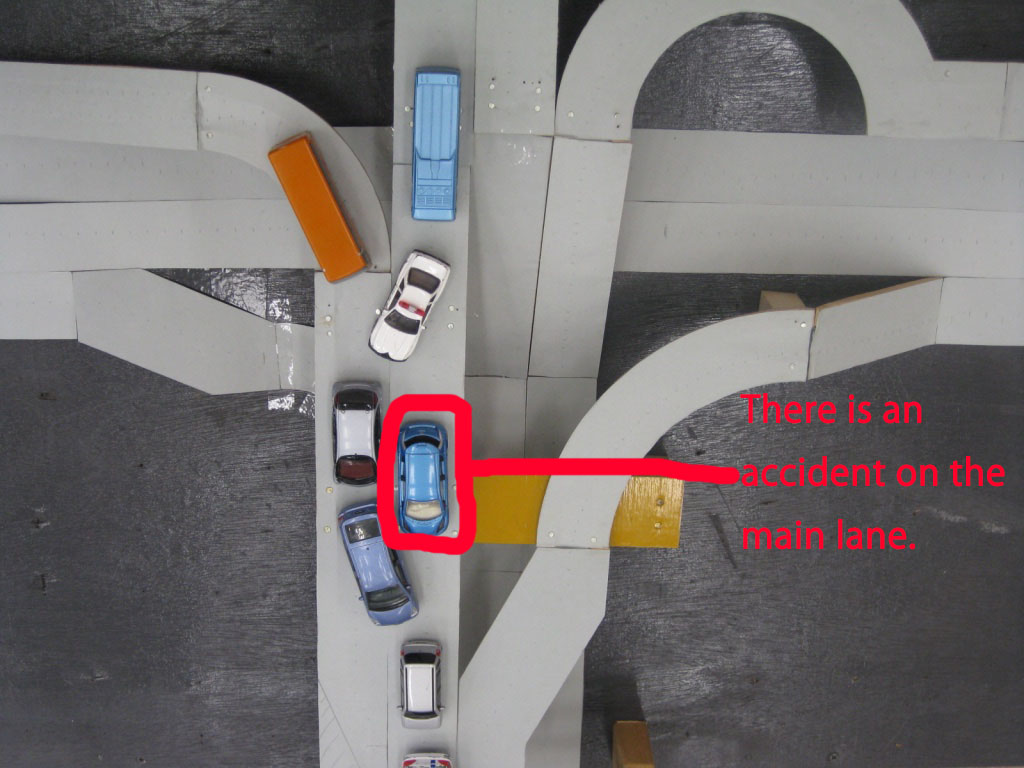
- ②Accident occurs in the sub-lane.
(Hypothesis)As long as the confluence section is not completely blocked, it seems that a big loss does not occur to that extent only by the shortening of the section.
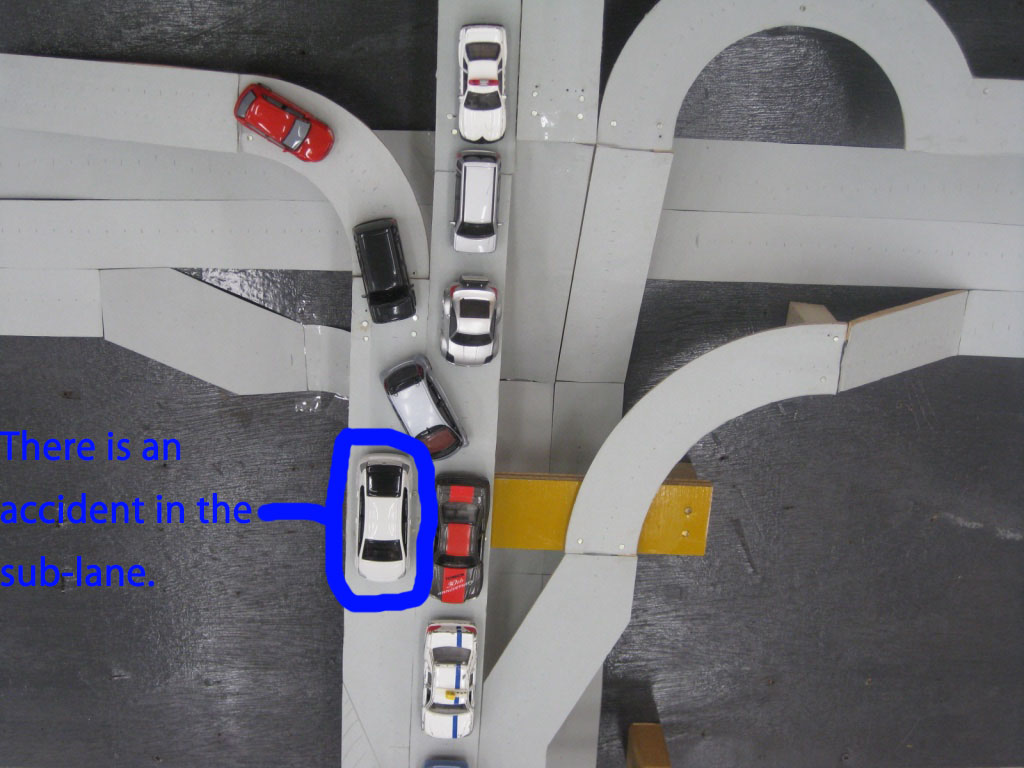
Results and Consideration
Experiment 1
| You can see it step by step with explanation. | You can see each experiment side-by-side. |
Result
- ①The main lane was crowded more intensely than the sub-lane.
- ②The sub-lane was crowded more intensely than the main lane.
- ③Cars could run at a relatively constant speed in both the main lane and the sub-lane.
Consideration
It turned out that it is unlikely that a heavy traffic jam will occur if the cars in the sub-lane join the main lane after two cars in the main lane pass.(It is necessary to change the pace at which cars in the sub-lane enter the main lane according to the traffic volume.)
Experiment 2
| You can see it step by step with explanation. | You can see each experiment side-by-side. |
Result
- ①You can see that there is a traffic jam caused by slowing down the speed of the cars on the slope.
- ②The cars run smoothly as they do the same kind of movement with the car running on a flat lane.
Consideration
When there was even one place where cars fell the speed, it turns out that the traffic jam became more intense than I thought.
Experiment 3
| You can see it step by step with explanation. | You can see each experiment side-by-side. |
Result
- ①Cars running in the main lane need to go around and a large loss occurs compared with ②.
- ②As a result, due to the shorter junction section between the main lane and the sub-lane, there is a possibility that traffic jams on the sub-lane may become longer, but there is no big loss compared to ①.
Consideration
A big loss will occur when an accident happens and there is no choice but to get on to another lane on the part that can run straight usually.
Summary
| Case where congestion frequently occurs | Reason(reference: Cause of Traffic Jams and Solutions) | Solutions |
|---|---|---|
| Joining | Every car (which runs in the lane of the side to join) will try to slow the speed in order to margin the cars (which run in the lane of the side to join main lane) that intend to join the main lane. | In order to avoid unnecessarily slow down of the car on the main lane, develop a mechanism that allows cars in the sub-lane to enter the main lane according to the traffic volume. |
| Curve or slope | If there is a car with a slow speed on a curve or slope, the car behind it will decrease in speed one after another. | Cars sense the angles of curves and slopes, and according to them, cars speed up more than usual so that cars can run at the same speed as the flat road as possible. |
| Accident | ①Speed decreases as the lanes become smaller.
②Drivers slow down to see the actual state of the accident. ③ If accident happens on a straight road, there is a high possibility that drivers have to change lanes several times. |
①It can be solved by applying the experiment solution at the merging time.
②If autonomous cars become popular, such problems can be solved. ③If an accident happens in a place that blocks a straight lane, the other cars around there recognizes the accident and will change lanes ahead of time. Also, it is considered that even if simply moving the car to a lane where it is not necessary to change the lane as much as possible when dealing with the accident after it happens, that will be an effective remedy. |
Questions from our experiments
| ① | Through our experiment
Through this experiment we tried to find out how to prevent traffic jams in three types of circumstances, “Joining”, ”Curve or Slope”, and ”Accidents”. However, the experiment was not so comprehensive for us to know how the situation would change get better or be worsen and to see the effect concretely by figuring the situation. →Thus, whether we simultaneously discuss not only those three cases, but also other situations that could happen on the road is the key. Also, when we apply technologies together, we need to clarify which technologies should be chosen in which situation. |
| What we want to suggest for society
When we look into performances of autonomous cars, we need to show how it would have been effected by numbers, not only by our imaginations. So, car enterprises which are developing new products should show what simulations they are doing in order to see the performance clearly. (We think it might lack information, if it is difficult for consumers to understand, companies cannot show how excellent the products are.) |
| ② | Through our experiment
In this experiment, we focused on Edobashi junction, which is especially prone traffic jams in the Metropolitan Express way. But we couldn’t figure out whether the result of this experiment is different or not for other junctions. We can say the intersection is short and there are a lot of curves and slopes in Edobashi junction. However, we couldn’t figure out what happened if there were a lot of large vehicles, for example, trucks near trading port. →When we put the system into practice , it is necessary to develop the system which enables traffic jams not only at certain places but also at various areas to be solved. |
| What we want to suggest for society When confirming the performance of an automobile, we cannot say that the purpose has not been fully achieved unless it cannot eliminate congestion not only in a specific country or region but in all places. Now that buying and selling cars has become global scale,so makers should develop the car according to the needs of the scale; otherwise it is possible to decrease the number of car sales. |
| ③ | Through our experiment
In this experiment we focused on only three conditions, “Joining”, “Curve or Slope” and “Accident”, so it might be difficult for us to completely prevent traffic jams completely. Moreover, we thought that we could create a better measure to solve the problems covering huge areas and various situations. Considering through more effective plan and the necessity for the plan after experiment. →When we put the system into practice, people should develop systems which covers various situations through considering more effective way by every experiments. |
| What we want to suggest for society However, the patterns of traffic jams happen seem to exist infinitely. So, the enterprises which are developing cars collect the information that pattern which was not able to be prevented even though using the latest technologies, and look into why traffic congestion occurred in the situation. Based on the result that why traffic congestion occurred, the enterprises develop solutions and inspect effect by using simulation. Every time developing the solutions, autonomous cars update the data. We think that we can avoid traffic congestion by doing many times. |
What I noticed through this experiment
To solve various problems, we found it is important to do many experiments based on various cases without being satisfied with one experiment.
Enterprises need more easy to understand explanations for consumers to realize the performance.
| ←BACK "Recovering from Traffic Jams" | NEXT→Our Conclusion |


 JAPANESE
JAPANESE ENGLISH
ENGLISH

